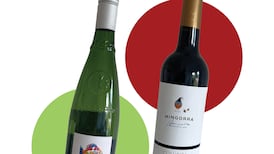I t was the land they couldn’t give away. Until the late 1990s, a large circular piece of ground in Hawke’s Bay on the east coast of New Zealand was considered next to useless. It consisted of 800 hectares of silt and gravel deposits left behind when the Ngaruroro river changed course a century ago.
Arid and infertile, unable even to sustain sheep farming, the land was used for industrial parks, go-kart tracks and even a few suburban estates. But mostly it was left idle. The only clue to its real value lay in the fact that a cement company used it to excavate gravel.
Over the last 20 years Gimblett Gravels has become one of the more sought-after pieces of real estate in New Zealand.
It is now recognised as a unique wine-growing area that can achieve something the rest of New Zealand has traditionally had difficulty doing: produce fully ripe red grapes.
It always grated a little with the macho New Zealand male that their country was best known for producing a white wine, Sauvignon Blanc. Even their premium red was Pinot Noir, a soft and silky wine, not the sort of thing a full-blooded Kiwi wanted to drink with his steak.
But Merlot, Cabernet Sauvignon and Syrah never really ripened in the cooler New Zealand climate. Hawke’s Bay had always been known as the best place to grow Cabernet and Merlot, the two Bordeaux varieties. It is warmer and drier than other wine regions.
But when growers began taking a closer look at the patchwork of soils that made up the region, they realised that the poorest driest gravel soils scattered throughout the region produced the ripest grapes, whereas those with heavier loam soils struggled.
Gimblett Gravels is not the only such site but it has certainly grabbed all the headlines over the last two decades.
John Hancock is an Australian who started out in New Zealand making wines for Morton Estate, one of the pioneering producers in Hawke’s Bay. He met Robert and Robyn Wilson, proprietors of the Bleeding Heart restaurant in London, and together they founded Trinity Hills, which became one of the groundbreaking wineries in Gimblett Gravels.
“The most special thing about Gimblett Gravels,” says Hancock, “is the ability to consistently ripen those varieties that we cannot ripen elsewhere. It isn’t because of extra sunshine or heat – we are no sunnier than other parts of Hawke’s Bay and other regions – but the radiation from the gravel soils reflects up to the vines both during the day and at night. In addition, the soils are very free draining.”
Those with a knowledge of Bordeaux, itself a fairly cool region, will remember that the best sites in the Médoc also have deep gravel soils.
Even in Gimblett Gravels and the other gravel soils of Hawke’s Bay, there can sometimes be problems ripening Cabernet Sauvignon. As in Bordeaux most growers have also planted the earlier-ripening Merlot and more recently Syrah and even Malbec.
According to Hancock, all Gimblett Gravels wines have a special character.
“In general they have very good colour, floral notes with every variety, ripe but never over-ripe blue fruits, often with hints of liquorice and reasonable alcohol levels. This is telling in their favour as tastes move towards lighter wines.”
New Zealand is still primarily known for Sauvignon Blanc and rightly so; it has been one of the huge success stories in the world of wine over the last decade, although as a country they still account for less than 0.5 per cent of world wine production. They just happen to be very good at exporting it, and we happen to like it lot. You will come across some Pinot Noir and the occasional Pinot Gris.
Beyond this New Zealand does produce some very good Chardonnay, certainly worth trying if you come across a bottle; this is something else Hawke’s Bay does very well. Red wines with the wider generic Hawke’s Bay designation may not have the cachet of those from Gimblett Gravels, but in recent years they have improved greatly and are more reasonably priced. I include two below.
Like the wines of Bordeaux, they go very well with roast red meat like lamb, that other great New Zealand export. l John Wilson's 120 Top Wines 2015, published by Irish Times Books, is in bookshops now, priced €12.99












